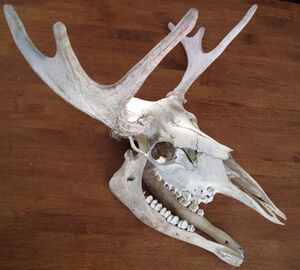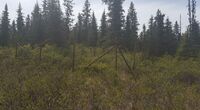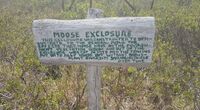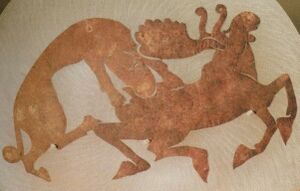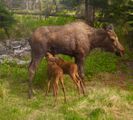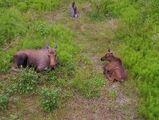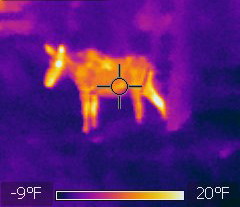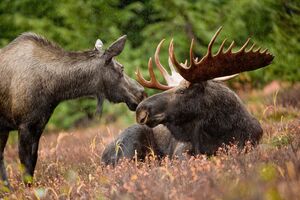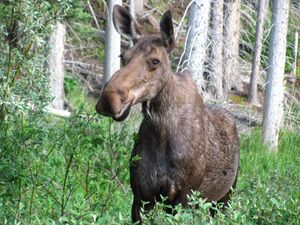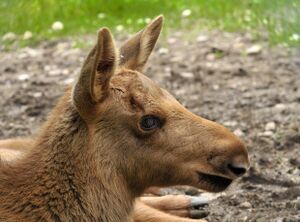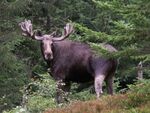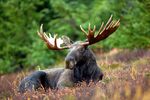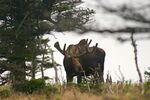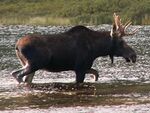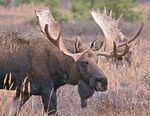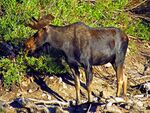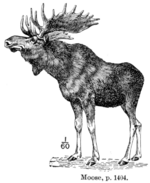موظ
| Moose | |
|---|---|
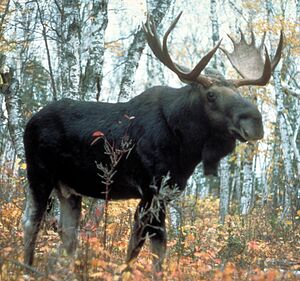
| |
| Male (bull) | |
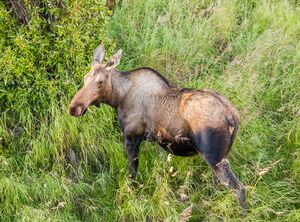
| |
| Female (cow) | |
| التصنيف العلمي | |
| أصنوفة غير معروفة (أصلحها): | Alces |
| Species: | Template:Taxonomy/AlcesA. alces
|
| Binomial name | |
| Template:Taxonomy/AlcesAlces alces | |
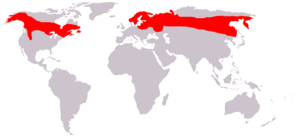
| |
| Moose range map | |
| Synonyms | |
|
Cervus alces Linnaeus, 1758 | |
The moose (in North America) or elk (in Eurasia) (Alces alces) is a member of the New World deer subfamily and is the largest and heaviest extant species in the deer family. Most adult male moose have distinctive broad, palmate ("open-hand shaped") antlers; most other members of the deer family have antlers with a dendritic ("twig-like") configuration. Moose typically inhabit boreal forests and temperate broadleaf and mixed forests of the Northern Hemisphere in temperate to subarctic climates. Hunting and other human activities have caused a reduction in the size of the moose's range over time. It has been reintroduced to some of its former habitats. Currently, most moose occur in Canada, Alaska, New England (with Maine having the most of the lower 48 states), New York State, Fennoscandia, the Baltic states, Poland, Kazakhstan and Russia.
Its diet consists of both terrestrial and aquatic vegetation. The most common predators of the moose are wolves, bears, and humans. Unlike most other deer species, moose do not form herds and are solitary animals, aside from calves who remain with their mother until the cow begins estrus (typically at 18 months after birth of the calf), at which point the cow chases them away. Although generally slow-moving and sedentary, moose can become aggressive, and move quickly if angered or startled. Their mating season in the autumn features energetic fights between males competing for a female.
. . . . . . . . . . . . . . . . . . . . . . . . . . . . . . . . . . . . . . . . . . . . . . . . . . . . . . . . . . . . . . . . . . . . . . . . . . . . . . . . . . . . . . . . . . . . . . . . . . . . . . . . . . . . . . . . . . . . . . . . . . . . . . . . . . . . . . . . . . . . . . . . . . . . . . . . . . . . . . . . . . . . . . . .
أصل الاسم والتسمية
Alces alces is called a "moose" in North American English, but an "elk" in British English.[4] The word "elk" in North American English refers to a completely different species of deer, Cervus canadensis, also called the wapiti. A mature male moose is called a bull, a mature female a cow, and an immature moose of either sex a calf.
According to the Oxford English Dictionary, the etymology of the species is "of obscure history".[4] In Classical Antiquity, the animal was known as ἄλκη álkē[5] in Greek and alces[6] in Latin, words probably borrowed from a Germanic language or another language of northern Europe.[4] By the 8th century, during the Early Middle Ages, the species was known as قالب:Lang-oe derived from the Proto-Germanic: *elho-, *elhon- and possibly connected with the نورسية القديمة: elgr.[4] Later, the species became known in Middle English as elk, elcke, or elke, appearing in the Latinized form alke, with the spelling alce borrowed directly from لاتينية: alces.[4][7] Noting that elk "is not the normal phonetic representative" of the Old English elch, the Oxford English Dictionary derives elk from قالب:Lang-gmh, itself from قالب:Lang-goh.[4]
The word "elk" has cognates in other Indo-European languages, e.g. elg in Danish/Norwegian; älg in Swedish; alnis in Latvian; Elch in German; and łoś in Polish.[8] In the continental European languages, these forms of the word "elk" always refer to Alces alces.
The youngest elk bones in Great Britain were found in Scotland and are roughly 3,900 years old.[9] The elk was probably extinct on the island before 900 AD.[10] The word "elk" remained in usage because of English-speakers' familiarity with the species in Continental Europe; however, without any living animals around to serve as a reference, the meaning became rather vague, and by the 17th century "elk" had a meaning similar to "large deer".[10] Dictionaries of the 18th century simply described "elk" as a deer that was "as large as a horse".[11]
Confusingly, the word "elk" is used in North America to refer to a different animal, Cervus canadensis, which is also called by the Algonquian indigenous name, "wapiti". The British began colonizing America in the 17th century, and found two common species of deer for which they had no names. The wapiti appeared very similar to the red deer of Europe (which itself was then almost extinct in Southern Britain) although it was much larger and was not red;[10] the two species are indeed closely related, though distinct behaviorally and genetically.[بحاجة لمصدر] The moose was a rather strange-looking deer to the colonists, and they often adopted local names for both. In the early days of American colonization, the wapiti was often called a gray moose and the moose was often called a black moose, but early accounts of the animals varied wildly, adding to the confusion.[12]
The word "moose" had first entered English by 1606[13] and is borrowed from the Algonquian languages (compare the Narragansett moos and Eastern Abenaki mos; according to early sources, these were likely derived from moosu, meaning "he strips off"),[14] and possibly involved forms from multiple languages mutually reinforcing one another. The Proto-Algonquian form was *mo·swa.[15]
Early European explorers in North America, particularly in Virginia where there were no moose, called the wapiti "elk" because of its size and resemblance to familiar-looking deer like the red deer.[16] The moose resembled the "German elk" (the moose of continental Europe), which was less familiar to the British colonists. For a long time neither species had an official name, but were called a variety of things. Eventually, in North America the wapiti became known as an elk while the moose retained its Anglicized Native-American name.[16] In 1736, Samuel Dale wrote to the Royal Society of Great Britain:
The common light-grey moose, called by the Indians, Wampoose, and the large or black-moose, which is the beast whose horns I herewith present. As to the grey moose, I take it to be no larger than what Mr. John Clayton, in his account of the Virginia Quadrupeds, calls the Elke ... was in all respects like those of our red-deer or stags, only larger ... The black moose is (by all that have hitherto writ of it) accounted a very large creature. ... The stag, buck, or male of this kind has a palmed horn, not like that of our common or fallow-deer, but the palm is much longer, and more like that of the German elke.[17]
الوصف والتشريح
Antlers
Bull moose have antlers like other members of the deer family. Cows select mates based on antler size. Bull moose use dominant displays of antlers to discourage competition and will spar or fight rivals.[18] The size and growth rate of antlers is determined by diet and age; symmetry reflects health.[18]
البيئة وعلم الأحياء
Diet
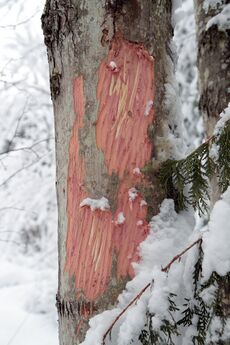
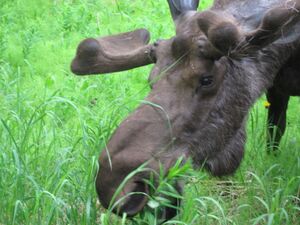
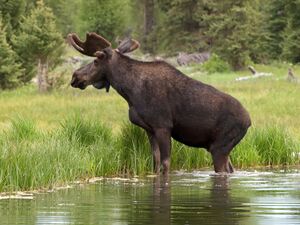
المفترسون الطبيعيون
الهيكل الاجتماعي والتكاثر
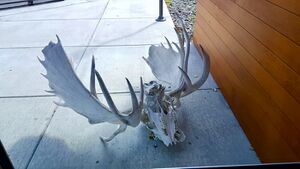
الموئل والنطاق والتوزع
الموئل
أمريكا الشمالية
. . . . . . . . . . . . . . . . . . . . . . . . . . . . . . . . . . . . . . . . . . . . . . . . . . . . . . . . . . . . . . . . . . . . . . . . . . . . . . . . . . . . . . . . . . . . . . . . . . . . . . . . . . . . . . . . . . . . . . . . . . . . . . . . . . . . . . . . . . . . . . . . . . . . . . . . . . . . . . . . . . . . . . . .
التجمعات
أمريكا الشمالية:
- In Canada : There are an estimated 500,000 to 1,000,000 moose,[19] with 150,000 in Newfoundland in 2007 descended from just four that were introduced in the 1900s.[20]
- In United States : There are estimated to be around 300,000:
- Alaska: The state's Department of Fish and Game estimated 200,000 in 2011.[21]
- Northeast: A wildlife ecologist estimated 50,000 in New York and New England in 2007, with expansion expected.[22]
- Rocky Mountain states: Wyoming is said to have the largest share in its 6-state region, and its Fish and Game Commission estimated 7,692 in 2009.[23]
- Upper Midwest: Michigan 2000 on Isle Royale (2019) and an estimated 433 (in its Upper Peninsula) in 2011,[24][25] Wisconsin, 20–40 (close to its border with Michigan) in 2003, Minnesota 5600 in its northeast in 2010,[26] and under 100 in its northwest in 2009;[27] North Dakota closed, due to low moose population, one of its moose-hunting geographic units in 2011, and issued 162 single-kill licenses to hunters, each restricted to one of the remaining nine units.[28]
أوروپا وآسيا:
- Finland : In 2009, there was a summer population of 115,000.[29]
- Norway : In 2009, there were a winter population of around 120,000.[30] In 2015 31,131 moose were shot. In 1999, a record number of 39,422 moose were shot.[31]
- Latvia : in 2015, there were 21,000.[32]
- Estonia : 13,260[33]
- Lithuania : around 14,000 in 2016[34]
- Poland : 2,800[35]
- Czech Republic : maximum of 50[35]
- Russia : In 2007, there were approximately 600,000.[36]
- Sweden : Summer population is estimated to be 300,000–400,000. Around 100,000 are shot each fall.[37][38] About 10,000 are killed in traffic accidents yearly.[39]
الأنواع الفرعية
| European elk | A. a. alces | Finland, Sweden, Norway, Latvia, Estonia and Russia. No longer present in central and western Europe except for Poland, Lithuania and Belarus, with a certain population in the Czech Republic, Slovakia and northern Ukraine, including Bohemia since the 1970s; recently sighted in eastern Germany (the range formerly included France, Switzerland and the Benelux nations). Population increasing and regaining territory. Males weigh about 320 to 475 kg (705 to 1,047 lb) and females weigh 275 to 375 kg (606 to 827 lb) in this mid-sized subspecies. Shoulder height ranges from 1.7 to 2.1 m (5 ft 7 in to 6 ft 11 in).[40] |
| Yakutia, Mid-Siberian or Lena elk[41] | A. a. pfizenmayeri | Eastern Siberia, Mongolia and Manchuria. Mostly found in the forests of eastern Russia. The most common elk subspecies in Asia. Its range goes from the Yenisei River in the west and most of Siberia. Its range excludes the ranges of the Chukotka and Ussuri elk to the east and northern Mongolia. Similar in size to the western moose of Canada. |
| Ussuri, Amur or Manchurian elk[41][42] | A. a. cameloides | Ranges from the Amur-Ussuri region of far eastern Russia, as well as the northeastern part of China. Ussuri elk are different from other elk subspecies in that their antler size is much smaller, or they lack antlers entirely. Even adult bulls' antlers are small and cervine, with little palmation. The smallest subspecies in both Eurasia and the world, with both males and females standing only 1.65 to 1.85 m (5 ft 5 in to 6 ft 1 in) at the shoulder and weighing between 200 and 350 kg (441 and 772 lb).[43] |
| Chukotka or East Siberian elk[41] | A. a. buturlini | Ranges from northeastern Siberia from the Alazeya River basin east to the Kolyma and Anadyr basins and south through the Koryak range and the Kamchatka Peninsula. The largest subspecies in Eurasia. Males can grow up to 2.15 m (7 ft 1 in) tall and weigh between 500 and 725 kg (1,102 and 1,598 lb); females are somewhat smaller. |
| Eastern moose | A. a. americana | Eastern Canada, including eastern Ontario, all of Quebec and the Atlantic Provinces and the northeastern United States, including Maine, New Hampshire, Vermont, Massachusetts, Rhode Island, Connecticut and northern New York near the Adirondack Mountains. Population increasing. This is a fairly small-bodied subspecies, females weighing an average of 270 kg (595 lb), males weighing an average of 365 kg (805 lb) and males standing up to approximately 2 m (6.6 ft) at the shoulder. |
| Western moose | A. a. andersoni | British Columbia to western Ontario, the eastern Yukon, the Northwest Territories, southwestern Nunavut, Michigan (the Upper Peninsula), northern Wisconsin, northern Minnesota and northeastern North Dakota. A middle-sized subspecies that weighs 340 to 420 kg (750 to 926 lb) in adult females and 450 to 500 kg (992 to 1,102 lb) in adult males on average.[44] |
| Alaskan moose | A. a. gigas | Alaska and the western Yukon. The largest subspecies in North America and the world and the largest living deer in the world, mass cited below.[45] |
| Shiras' moose or Yellowstone moose | A. a. shirasi | Colorado, Idaho, Montana, Oregon, Utah, Washington and Wyoming.[46] The smallest subspecies in North America, weighing about 230 to 344 kg (507 to 758 lb) at maturity. |
| † Caucasian elk[47] | A. a. caucasicus | The Caucasus Mountains. Extinct due to habitat loss and overhunting. Its range would have included European Russia, Armenia, Georgia, Azerbaijan and Turkey. |
انظر أيضاً
- Älgen Stolta, a rare example of a domesticated moose
المراجع
- ^ "I giacimenti quaternari di vertebrati fossili nell'Italia nord-orientale". Memorie di Scienze Geologiche. 43. January 1991.
- ^ "Alces alces Linnaeus 1758 (moose)". PBDB. Archived from the original on 2020-08-04.
- ^ Hundertmark, K. (2016). "Alces alces". IUCN Red List of Threatened Species. 2016: e.T56003281A22157381. doi:10.2305/IUCN.UK.2016-1.RLTS.T56003281A22157381.en. Retrieved 19 November 2021.
- ^ أ ب ت ث ج ح "elk, n. 1". Oxford English Dictionary (2nd ed.). 1989 [1891]. Retrieved January 15, 2021.
- ^ ἄλκη. Liddell, Henry George; Scott, Robert; A Greek–English Lexicon at the Perseus Project.
- ^ قالب:L&S
- ^ "alce, n.". Oxford English Dictionary (3rd ed.). 2012. Retrieved January 15, 2021.
- ^ قالب:OEtymD
- ^ Feral: Rewilding the Land, the Sea, and Human Life By George Monbiot. University of Chicago Press. 2014. p. 124.
- ^ أ ب ت Mallory, J. P.; Adams, D. Q. (2006). The Oxford introduction to Proto-Indo-European and the Proto-Indo-European World. Oxford University Press. pp. 133–134.
- ^ Bailey, Nathan (1731). An Universal Etymological English Dictionary Royal Exchange. Page EL--EM.
- ^ Royal Society (Great Britain) (1736). Philosophical Transactions and Collections, Volume 9. p.84.
- ^ قالب:OED
- ^ قالب:OED
- ^ قالب:Dictionary.com
- ^ أ ب The Book of Animal Ignorance: Everything You Think You Know Is Wrong By John Mitchinson, John Lloyd -- Harmony Books 2007 Page 141
- ^ Philosophical Transactions and Collections Volume 9 By Royal Society (Great Britain) 1736 Page 85
- ^ أ ب خطأ استشهاد: وسم
<ref>غير صحيح؛ لا نص تم توفيره للمراجع المسماةRodgers2001a - ^ "Hinterland Who's Who". Hww.ca. Archived from the original on April 24, 2013. Retrieved May 25, 2013.
- ^ "Newfoundland's 120,000 moose are descended from just four that were introduced a century ago". Canadacool.com. Archived from the original on July 24, 2011.
- ^ Interior Alaska Moose News (Fall 2011) Archived فبراير 20, 2016 at the Wayback Machine, p. 6, "How Do Scandinavia and Alaska Compare?"
- ^ خطأ استشهاد: وسم
<ref>غير صحيح؛ لا نص تم توفيره للمراجع المسماةdefenders.org - ^ "Wyoming moose numbers fall short" Archived أبريل 30, 2017 at the Wayback Machine, Billings Gazette, May 28, 2009
- ^ Isle Royale: Wolf & Moose Populations, National Park Service
- ^ "DNRE Survey Results Indicate Approximately 433 Moose in Western Upper Peninsula". Michigan.gov. May 25, 2017. Archived from the original on October 29, 2013. Retrieved June 4, 2018.
- ^ "2010 Aerial Moose Survey" (PDF). Archived from the original (PDF) on August 8, 2017. Retrieved June 4, 2018.
- ^ "Moose Management and Research Plan Update" (PDF). Archived (PDF) from the original on November 13, 2018. Retrieved June 4, 2018.
- ^ "Big Game Hunting: Moose Season Information" Archived نوفمبر 9, 2011 at the Wayback Machine, North Dakota Game and Fish Department
- ^ RiistaWeb Archived يوليو 24, 2010 at the Wayback Machine. Riistaweb.riista.fi. Retrieved on January 9, 2011.
- ^ "Elgen truer skogen". Aftenposten (in النرويجية). Archived from the original on November 6, 2016. Retrieved September 19, 2016.
- ^ "Elgjakt, 2015/2016". Statistisk sentralbyrå. Archived from the original on December 1, 2017. Retrieved September 19, 2016.
- ^ "zm.gov.lv" (in اللاتفية). zm.gov.lv. Archived from the original on October 6, 2015. Retrieved October 6, 2015.
- ^ "Põtrade arvukust tahetakse oluliselt vähendada." Archived يونيو 27, 2013 at the Wayback Machine Postimees June 26, 2013. Retrieved June 27, 2013. (in إستونية)
- ^ Lietuvą pamėgo meškėnai, o rudiesiems lokiams vietos čia per mažai, lrt.lt, 2017.02.10 Archived 10 يناير 2019 at the Wayback Machine
- ^ أ ب "Factsheet: Eurasian Elk (Elk, reindeer, roe deer (Cetartiodactyla Cervidae Capreolinae) > Alces alces)". Lhnet.org. Archived from the original on July 27, 2013. Retrieved June 27, 2013.
- ^ Baskin, Leonid M. (2009). "Status of Regional Moose Populations in European and Asiatic Russia". Alces. 45: 1–4. Archived from the original on February 26, 2018. Retrieved February 26, 2018.
- ^ "jagareforbundet.se" (in السويدية). jagareforbundet.se. Archived from the original on December 3, 2013. Retrieved December 1, 2013.
- ^ salenalgen.se Om älgar Archived يونيو 20, 2012 at the Wayback Machine
- ^ "Så många djur dödas i trafiken varje år | SvD". Svenska Dagbladet. Svd.se. December 29, 2003. Archived from the original on September 25, 2018. Retrieved June 4, 2018.
- ^ Smith, A. T., Xie, Y., Hoffmann, R. S., Lunde, D., MacKinnon, J., Wilson, D. E., & Wozencraft, W. C. (Eds.). (2010). A guide to the mammals of China Archived سبتمبر 19, 2015 at the Wayback Machine. Princeton University Press.
- ^ أ ب ت "Asian Moose". Bear Creek Journal. Archived from the original on June 20, 2013. Retrieved June 27, 2013.
- ^ Kevin Jackson, 2009, Moose, Reaktion Books
- ^ Jackson, K. (2009). Moose. Reaktion Books.
- ^ "Moose in British Columbia" (PDF). Ministry of Environment, Lands and Parks, British Columbia. Archived (PDF) from the original on December 22, 2014. Retrieved August 18, 2014.
- ^ Franzmann, A. W., LeResche, R. E., Rausch, R. A., & Oldemeyer, J. L. (1978). Alaskan moose measurements and weights and measurement-weight relationships. Canadian Journal of Zoology, 56(2), 298-306.
- ^ "Moose Status and Hunting in Washington By Dana L. Base, Associate Wildlife Biologist August 2004". Archived from the original on June 21, 2007. Retrieved December 7, 2009.
- ^ Wrobel, Murray (November 18, 2006). Elsevier's Dictionary of Mammals (in الإنجليزية). Elsevier. ISBN 9780080488820.
<ref> ذو الاسم "spieg120903" المُعرّف في <references> غير مستخدم في النص السابق.للاستزادة
- Alces: A journal devoted to the biology and management of moose (Alces alces) Centre for Northern Forest Ecosystem Research.
- DuTemple, Lesley A. (February 1, 2000). North American Moose. Lerner Publications. ISBN 9781575054261.
- Geist, Valerius; Francis, Michael H. (November 1999). Moose: Behavior, Ecology, Conservation. Voyageur Press (MN). ISBN 978-0-89658-422-8.
- Promack, Jennie; Sanker, Thomas J. (June 1, 1992). Seasons of the Moose. Gibbs Smith. ISBN 9780879054557.
- Strong, Paul (May 1998). Wild Moose Country (illustrated ed.). Cowles Creative Publishing. ISBN 978-1-55971-638-3.
. . . . . . . . . . . . . . . . . . . . . . . . . . . . . . . . . . . . . . . . . . . . . . . . . . . . . . . . . . . . . . . . . . . . . . . . . . . . . . . . . . . . . . . . . . . . . . . . . . . . . . . . . . . . . . . . . . . . . . . . . . . . . . . . . . . . . . . . . . . . . . . . . . . . . . . . . . . . . . . . . . . . . . . .
وصلات خارجية
- Articles containing Ancient Greek (to 1453)-language text
- CS1 النرويجية-language sources (no)
- CS1 اللاتفية-language sources (lv)
- Articles with إستونية-language sources (et)
- CS1 السويدية-language sources (sv)
- Short description is different from Wikidata
- IUCN Red List least concern species
- Automatic taxobox cleanup
- Articles containing لاتينية-language text
- Articles containing نورسية القديمة-language text
- Articles with unsourced statements from December 2020
- موظ
- Holarctic fauna
- Mammals of Asia
- Mammals of Canada
- Mammals of China
- Mammals of Europe
- Mammals of Mongolia
- Mammals of Russia
- Mammals of the Arctic
- Mammals of the United States
- Fauna of Siberia
- Hunting in the United States
- Mammals described in 1758
- أصنوفات سماها كارل لينايوس
- Symbols of Alaska


